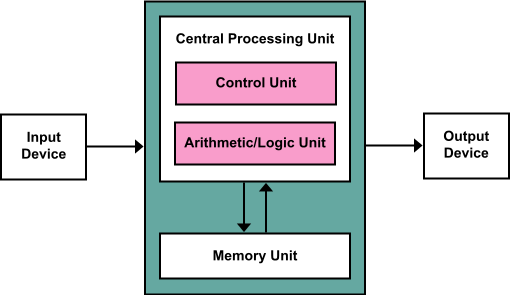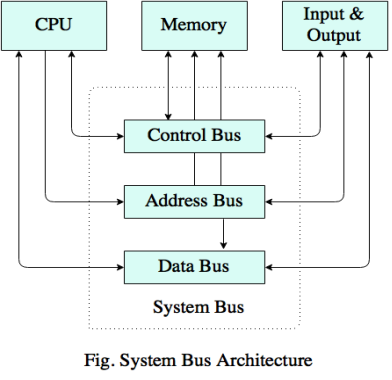Explain Different Types of Cpu Organization
Long Term Scheduler. What are The Different Types of Pointing Devices Include.

Architecture Of The Central Processing Unit Cpu Computer Science Wiki
A accumulator based CPU consists of a data processing unit b program control unit and c memory and IO interface unit.

. Computer - Information Technology. Different Instruction Cycles. Whenever CPU requires any word It first searches for the word in level-1.
Micro Operations The primary function of a processor unit is to execute sequence of instructions stored in a memory. Data transfer between the central computer and IO devices may be handled in a variety of modes. The CPU registers can be broadly split into two types.
The External Interrupt occurs when any Input and Output Device request for any Operation and the CPU will Execute that instructions first For Example When a Program is executed and when we move the. A i In the data processing unit data is processed to get some. The different types of CPU registers include.
Level-3 is directly connected to level-2 and so on. Described below are the four types of Computers based on their sizes along with their functions. Lets take a look at the different types of addressing modes one at a time now.
The job scheduler or long-term scheduler selects processes from the storage pool in the secondary memory and loads them into the ready queue in the main memory for execution. These devices share the system bus and when a current master bus relinquishes another bus can acquire the control of the processor. Computer - Personal Computer.
With immediate addressing mode the actual data to be used as the operand. The Operation code Opcode field which specifies the operation to be performed. The keyboard is an essential input device and computer and laptops both use keyboards to give commands to the computer.
Vertical Micro-programmed Control Unit Hardwired vs Micro-programmed Control Unit Non-Restoring Division Algorithm for Unsigned Integer Restoring Division Algorithm for Unsigned Integer Debugging a Machine-level Program Dependencies and Data Hazard in pipeline in Computer Organization Execution Stages and Throughput in Pipeline Types of Pipeline Delay. Micro Computers A relatively inexpensive and small computer comprising a microprocessor and a Central Processing Unit CPU is called a Microcomputer. Generally there are three types o Interrupts those are Occurred For Example.
Fetch cycle decode cycle and execute cycle. Following are some of the important input devices which are used in a computer. The sequence of operation involved in processing an instruction constitutes an instruction cycle which can be divided into three major phases.
Bus arbitration is a process by which next device becomes the bus controller by transferring bus mastership. In a computer system there may be more than one bus master such as a DMA controller or a processor etc. The long-term scheduler controls the degree of multiprogramming.
An Example An instruction set has three instruction classes. Instruction Types CPI. A unidirectional pathway information can only flow one way.
CPU cycles for sequence 1 2 x 1 1 x 2 2 x 3 10 cycles CPI for sequence 1 clock cycles instruction count 10 5 2 CPU cycles for sequence 2 4 x 1 1 x 2 1 x 3 9 cycles. Carries the control and timing signals needed to coordinate the activities of the entire computer. A bi-directional pathway information can flow in two directions.
Two code sequences have the following instruction counts. The Fetch Cycle. Computer - Data and Information.
The CPU registers can either be programmer accessible and some registers are non-accessible registers to the programmer. The first type of CPU registers are general purpose registers and the second type is special purpose registers. Others transfer the data directly to and from the memory unit.
Types of Addressing Modes. The Mode field which specifies how the operand will be located. The address in the program counter is moved to the memory address register MAR as this is the only register which is connected to address lines of the system bus.
Hierarchical Access Memory Organization- In this memory organization memory levels are organized as-Level-1 is directly connected to the CPU. At the beginning of the fetch cycle the address of the next instruction to be executed is in the Program Counter PC. The Address field which contains the location of the operand ie register or memory location.
Some modes use the CPU as an intermediate path. Once all this is decided this information has to be presented to the processor in the form of an instruction format. The number of bits in the instruction is divided into groups called fields.
This pointer is used to perform different tasks associated with the mouse. It must select a careful mixture of IO bound and CPU bound processes to yield. An instruction comprises of groups called fields.
The previous sections have shown you that the processor can execute different types of instructions and there are different ways of specifying the operands. Such computers are made with minimal circuitry mounting over a single circuit board. Data transfer to and from peripherals may be handled in one of three possible modes.
Level-2 is directly connected to level-1.

Computer Cpu Central Processing Unit

Cpu Organization Types Cpu Organization Types Single Accumulator Based Cpu Organization General Studocu

0 Response to "Explain Different Types of Cpu Organization"
Post a Comment